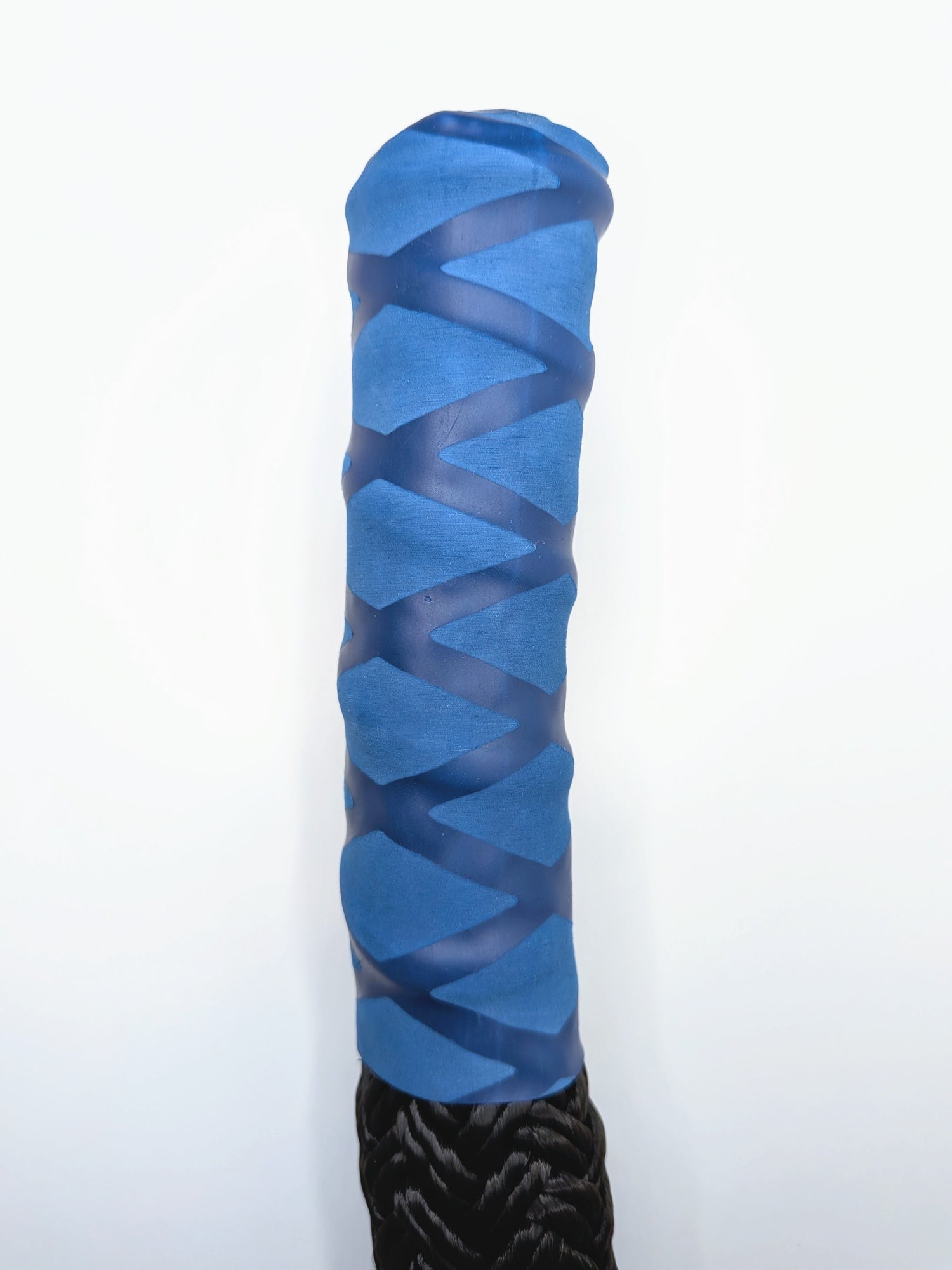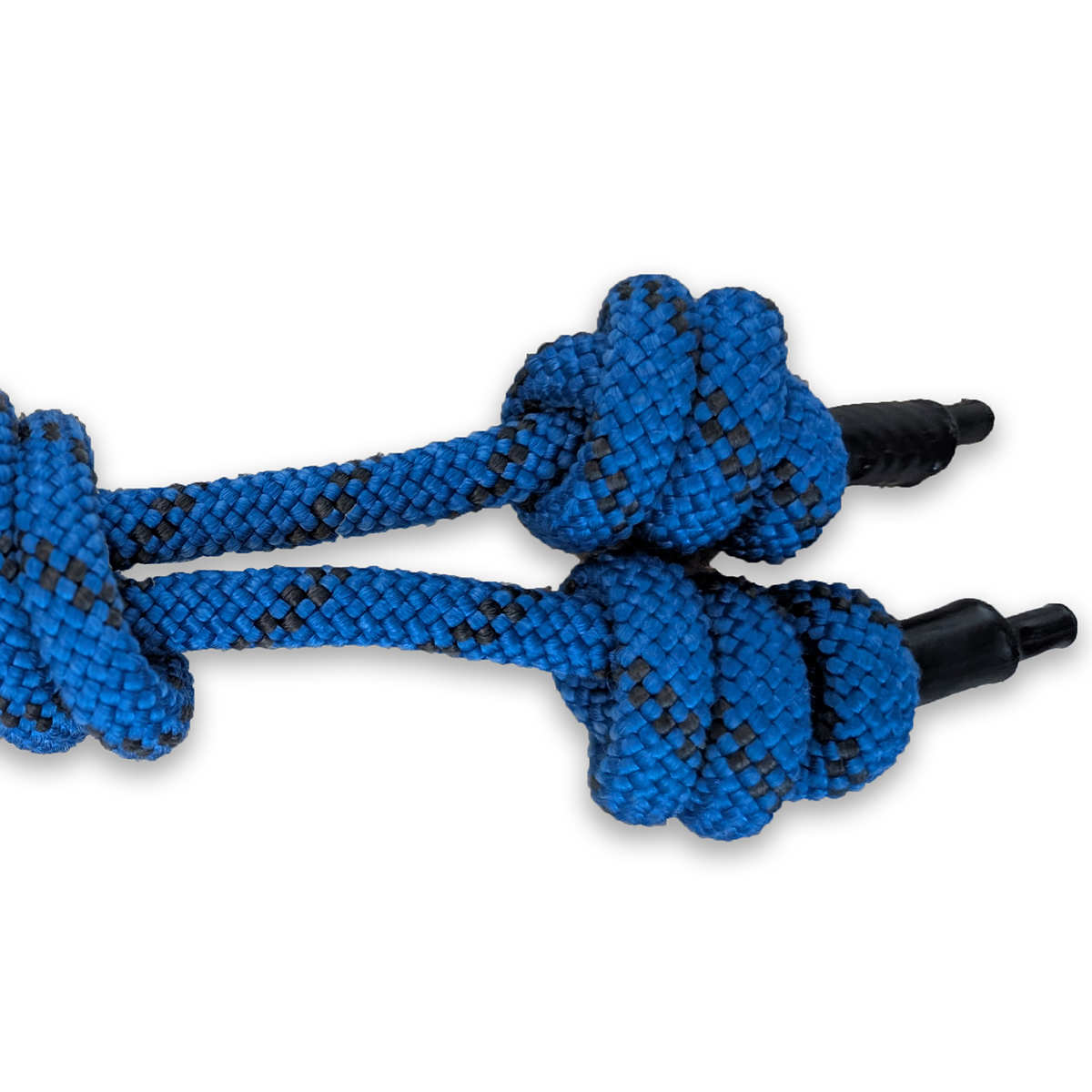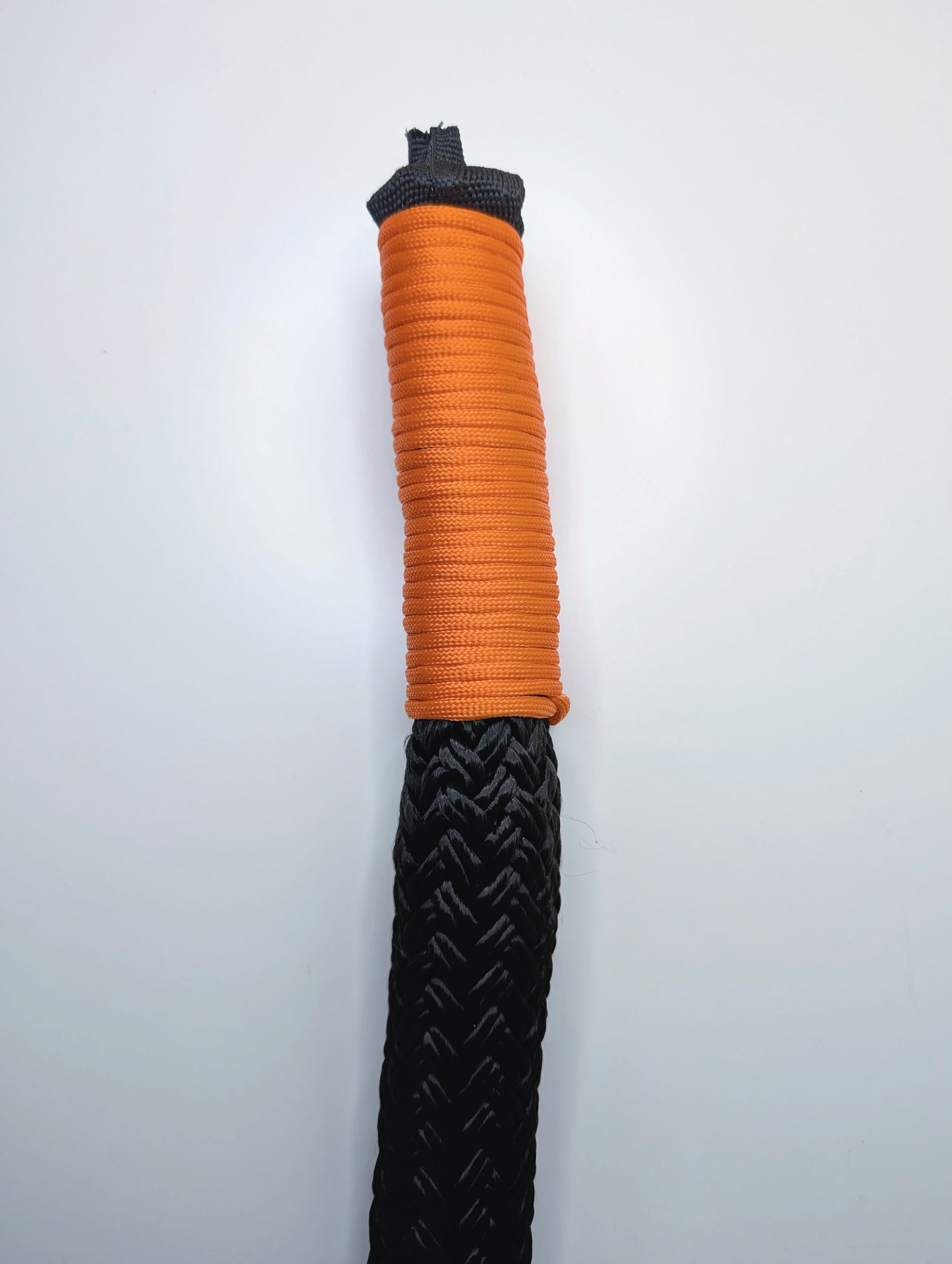Choosing a Flow Rope
Thinking of making your own rope or buying one? Here’s everything you need to know:
📏 Length
Flow ropes are shorter than skipping ropes and designed to gently tap the ground during a natural, relaxed swing. The right length helps you move smoothly and comfortably.
- Too long: The rope will bounce up after hitting the ground, breaking your rhythm. It also increases wear and tear from excessive friction.
- Too short: Reduces range of motion, gives less feedback, and requires tighter arm control - making it harder to learn.
Collapsible content
How to Measure
To find the right length for your body:
- Stand on the middle of the rope with one foot.
- Pull both ends up.
- The ends (or handles) should reach just above your belly button.
For most adults between 5’5” and 6’0” (165–183 cm), an 8 feet (244 cm) rope from handle to handle, or 11 feet (335 cm) total length uncoiled—works well.
Adjusting Length
If you're uncertain about length, it's always better to size up, then shorten as desired.
Avoid cutting your rope. Instead, shorten it with symmetrical knots like figure-eights or overhands about 5 inches (13 cm) from each end.
Note: If left in long-term, these knots may cause permanent bends in the rope. That’s fine if you keep the length, but less ideal if you plan to undo them later.
Watch the video below to see how to size and adjust your rope.
➰ Thickness & Weight
Both weight and thickness affect how a rope moves and feels in your hands. Generally, the thicker a rope, the heavier and stiffer it is. The right combo can make learning easier and more enjoyable, especially if you're new to rope flow or returning to movement.
-
Light
- Weight: <500g (1.1 lbs)
- Thickness: <14mm (≈ ½ inch)
- Best for: Beginners, seniors, children, or advanced users looking to speed flow
- Benefits: Easier to control, less tiring, ideal for learning basic patterns and moving with less strain
-
Medium
- Weight: 500–600g (1.1–1.3 lbs)
- Thickness: 16–19mm (≈ ⅝–¾ inch)
- Best for: Most adults - offers a good balance between feedback and flow
- Benefits: Provides more tactile feedback to help you feel the rhythm
-
Heavy
Coming Soon- Weight: 600g> (1.3+ lbs)
- Thickness: 25mm> (1 inch+)
- Best for: Experienced users or those focusing on strength and resistance
- Benefits: Engages more muscle and builds endurance - but fatigues you faster
-

Light Ropes
Weight: <500g (1.1 lbs) Thickness: <14mm (≈ ½ inch) Best for: Beginners, seniors, children, or...
-

Medium Ropes
Weight: 500–600g (1.1–1.3 lbs) Thickness: 16–19mm (≈ ⅝–¾ inch) Best for: Most adults - offers...
-

Heavy Ropes
Weight: 600g> (1.3+ lbs) Thickness: 25mm> (1 inch+) Best for: Experienced users or those focusing...
If you’re fit, it's tempting to start with a heavier rope. But fatigue can quickly set in and make it harder to maintain proper form. Straining often leads to overcompensating with incorrect movements and causes you to develop bad habits.
Start with a lighter rope to build skill and coordination - then gradually increase weight and experiment with length as you progress.
Remember: The best rope is the one that keeps you moving 🧡
🧵 Type & Material
Collapsible content
Not Just Any Rope
A good flow rope isn’t just a jump rope or clothesline. The key is in the weight and feel - achieved with a double-braided design: a strong inner core wrapped in a durable outer layer. Climbing and marine ropes are excellent choices.
What to Look For
- Durability: Nylon-blend, polyester, or marine-grade double-braided ropes last the longest.
- Flexibility: Firm enough to hold shape, soft enough to move fluidly.
- Avoid: Cheap PVC, cotton, or stiff hardware-store ropes - they tangle, don’t flow well, and wear out fast.
Tip: Ask Your Local SAR or Fire Station
These ropes are often in great shape—especially in Canada, where SAR ropes are retired after 5 years, even if unused. They may be removed from service due to wear or shortening, but most of the rope is still usable.
Buy them to support their operations and help reduce waste through upcycling.
Why Buy From Me
I’ve already done the hard work for you:
- Sourced the right kind of ropes.
- Thoroughly cleaned and dried them.
- Cut them to ideal lengths.
- Heat-sealed the ends to prevent fraying.
My ropes are intentionally priced low to make rope flow more accessible and encourage adoption!
✊ Grip & Handle Options
Flow ropes don’t need traditional jump rope handles. Instead, they use simple end finishes for grip and durability:

Taped/Wrapped
Wrapped with electrical tape or heat shrink tubing for grip and to prevent fraying - light and comfortable without added bulk.
(Image: Elderberry Obsidian heavy flow rope with wrapped handles)

Knotted
The Stopper Knot with 2-3 loops is the most common.
The Multiple Overhand Knot is an alternative - less secure but easier for stiff ropes.
(Image: Blueberry Crush Flow Rope with a 2 loop stopper knot and heat shrink tubing end caps.)

Whipped
For thicker or stiffer ropes that are hard to knot, wrapping the ends tightly with a smaller rope (called whipping) creates a durable grip.
(Image: Elderberry Obsidian heavy flow rope with heat shrink tubing end cap + whipped handles)
How to create a Handle or Grip for your Flow Rope
Heat Shrinking the ends of Flow Ropes
🌦️ Care & Maintenance
Flow ropes will wear down with use (especially where they strike the ground) but proper care can extend their life:
Collapsible content
Use on smooth surfaces
Stick to grass, rubber flooring, hardwood, yoga mats, or clean pavement.
You can wrap the apex of your rope (where it hits the ground) with electrical tape, duct tape, or kinesiology tape for added protection. However:
- It may affect the rope’s feel and flow.
- Removing the tape can damage the fibers or leave sticky residue.
Only do this if you’re certain it’s worth the trade-off.
Avoid
Rough concrete or gravel - they cause fraying.
Cleaning
Hand wash in warm water with mild soap or rope-safe cleaners. Disinfecting wipes are also an option. Never use bleach. Rinse thoroughly if it has been exposed to saltwater.
Drying
Air dry or tumble dry on low heat. Avoid direct sun or high heat, which can weaken the rope. Store in a cool, dry place to prevent mold or mildew.
Heavy Ropes: Avoid dryers as they can cause the handles to come undone, or worse, the core to become separated from the sheath. Air dry for up to 72 hours with a fan if possible.
Check the Ends
Re-tape or re-wrap them when they start to wear.
Rope Shrinkage/Swelling
Is normal over the lifetime of a rope. Minimizing water exposure reduces this.
Rope Repair
If the apex of your rope start to fray, you can gently reseal the fibers using a heat gun or by quickly passing it over a low flame.
Caution: Avoid high heat. Too much can burn the rope or fuse the fibers, making it stiff or brittle. Use just enough heat to slightly melt the stray fibers and prevent further fraying.
If the outer sheath of your rope wears down and the inner core becomes visible, your rope is nearing the end of its life.
Taping it with electrical, duct, or kinesiology tape may offer a short-term fix, but it won’t restore the rope’s original feel or function.
At this stage, you can either keep flowing until it fully wears out, or consider replacing it for a better experience.
Taking Care of and Maintaining Your Flow Rope
Rope Flow Manufacturing Process
Find Your Rope
-

Light Ropes
Weight: <500g (1.1 lbs) Thickness: <14mm (≈ ½ inch) Best for: Beginners, seniors, children, or...
-

Medium Ropes
Weight: 500–600g (1.1–1.3 lbs) Thickness: 16–19mm (≈ ⅝–¾ inch) Best for: Most adults - offers...
-

Heavy Ropes
Weight: 600g> (1.3+ lbs) Thickness: 25mm> (1 inch+) Best for: Experienced users or those focusing...



